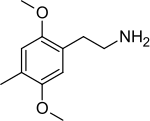2C-D
 | |||
| |||
| Names | |||
|---|---|---|---|
| IUPAC name
1-(2,5-Dimethoxy-4-methylphenyl)-2-aminoethane | |||
| Other names
2,5-Dimethoxy-4-methyl-phenethylamine, 4-Methyl-2,5-dimethoxyphenethylamine | |||
| Identifiers | |||
3D model (JSmol) |
|||
| ChEMBL | |||
| ChemSpider | |||
PubChem CID |
|||
| |||
| |||
| Properties | |||
| C11H17NO2 | |||
| Molar mass | 195.26 g/mol | ||
| Melting point | 213 to 214 °C (415 to 417 °F; 486 to 487 K) (hydrochloride) | ||
Except where otherwise noted, data are given for materials in their standard state (at 25 °C [77 °F], 100 kPa). | |||
| Infobox references | |||
2C-D (2,5-dimethoxy-4-methylphenethylamine, also known as 2C-M) is a psychedelic drug of the 2C family that is sometimes used as an entheogen. It was first synthesized in 1970 by a team from the Texas Research Institute of Mental Sciences,[1] and its activity was subsequently investigated in humans by Alexander Shulgin. The full name of the chemical is 2,5-dimethoxy-4-methylphenethylamine. In his book PiHKAL (Phenethylamines i Have Known And Loved), Shulgin lists the dosage range as being from 20 to 60 mg and many people recommend higher doses. Lower doses (generally 10 mg or less) of 2C-D have been explored as a potential nootropic, albeit with mixed results. 2C-D is generally taken orally, though may be insufflated (i.e. taken nasally). Insufflating tends to cause intense pain, however, and the dosage level is usually much lower, typically in the region of 1 to 15 mg.
Not much information is known about the toxicity of 2C-D, as no major studies have been conducted. According to Shulgin, the effects of 2C-D typically last for 4–6 hours. Shulgin himself referred to this substance as a “pharmacological tofu,” meaning that when mixed with other substances, it can extend or potentiate their effects without coloring the experience too much, in a manner similar to how tofu absorbs the flavors of sauces or spices it is cooked with. Some people have claimed 2C-D is relatively uninteresting on its own, but many other users have strongly disagreed with this assessment and believe instead 2C-D to be a true psychedelic in its own right. Hanscarl Leuner, working in Germany, explored the use of 2C-D under the name LE-25 in psychotherapeutic research.
Drug prohibition laws
China
As of October 2015 2C-D is a controlled substance in China.[2]
Canada
As of October 31, 2016; 2C-D is a controlled substance (Schedule III) in Canada. http://gazette.gc.ca/rp-pr/p2/2016/2016-05-04/html/sor-dors72-eng.php
Denmark
2C-D is added to the list of Schedule B controlled substances.[3]
Germany
2C-D is a Anlage I controlled drug.
Sweden
Sveriges riksdags health ministry Statens folkhälsoinstitut classified 2C-D as "health hazard" under the act Lagen om förbud mot vissa hälsofarliga varor (translated Act on the Prohibition of Certain Goods Dangerous to Health) as of Mar 1, 2005, in their regulation SFS 2005:26 listed as 2,5-dimetoxi-4-metylfenetylamin (2C-D), making it illegal to sell or possess.[4]
USA
2C-D became a Schedule I Controlled Substance in the United States as of July 9, 2012, with the signing of S. 3187 into law by President Barack Obama. On a state level, both Oklahoma and Pennsylvania list 2C-D under schedule I.
References
- ↑ Ho BT, Tansey LW, Balster RL, An R, McIsaac WM, Harris RT (January 1970). "Amphetamine analogs. II. Methylated phenethylamines". Journal of Medicinal Chemistry. 13 (1): 134–5. doi:10.1021/jm00295a034. PMID 5412084.
- ↑ "关于印发《非药用类麻醉药品和精神药品列管办法》的通知" (in Chinese). China Food and Drug Administration. 27 September 2015. Retrieved 1 October 2015.
- ↑ https://www.retsinformation.dk/Forms/R0710.aspx?id=137169
- ↑ http://www.notisum.se/rnp/sls/sfs/20050026.pdf

